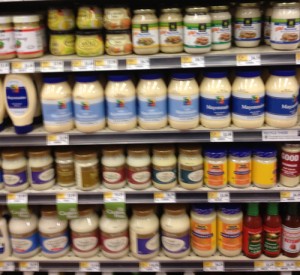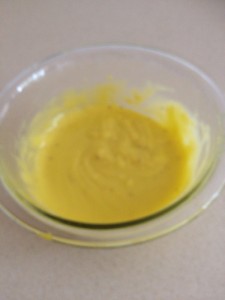
So much Mayonnaise and only 1 fit to eat
So there I was at Whole Foods, doing a little bit of grocery shopping. I saw a package of egg salad at the deli counter and thought to myself that it would be nice to make some. I always have pastured eggs at home, but I don’t usually have mayonnaise.
I know it’s a staple in most people’s homes, but I’ve never liked it. The last time I had a jar at home, it sat there more than half filled for a year and I finally tossed it. I tend to use it for deviled eggs or egg salad. It’s never been something I’ve used on a constant basis.
With my newfound knowledge of food labels, I started looking at them. With the exception of 1 small jar (that small jar on the top shelf, 2nd type from the left which was made with olive oil and priced at $7.99), every single bottle of mayonnaise was made with soy or canola oil, even the organic ones. As we now know, anything that isn’t organic soy or canola is most likely GMO. So anything non-organic was out. But I don’t want to eat organic canola or soy oil either.
Canola oil is genetically engineered from rapeseed. The word Canola comes from “CANadian Oil Low Acid”. Not something I want to put in my body, even (especially) when its been genetically modified. It’s a cheap oil to make which is why it has made its way into a lot of our processed foods. (Remember, the processed foods industry doesn’t care about our health, it’s about how much profit they can make.
Unfermented soy is another one I avoid. Actually I’m avoiding all soy right now, but traditionally fermented soy foods (and I do mean traditional, not the tofu you buy in those little packages) are fermented for a reason.
Unfermented soy (which is the soy contained in all Western processed foods) contains natural toxins known as “anti-nutrients”. These anti-nutrients interfere with the enzymes needed to digest protein. It interferes with thyroid function and blocks mineral absorption.
Unfermented soy has been linked to breast cancer, thyroid disorders, kidney stones, brain damage, immune system issues, impaired fertility and fatal food allergies. It’s definitely not something I want to eat, and not something I would recommend.
So there was no way I was going to buy any of these jars of mayonnaise. But while I’ve never done it, I knew that I could make mayonnaise. I’ve thought about making it before, but I’ve been intimidated. But I want my egg salad darn it. So if I can’t buy it, I’ll have to make it.
So digging on the web, I found a recipe on Epicurious for Homemade Mayonnaise. The recipe was published in Bon Appetit in April 2008. While the recipe has canola oil in it, I just substituted olive oil.
HomeMade Mayonnaise
Makes 3/4 Cup. Average Serving Size 1 Tablespoon. Makes 12 Tablespoons.
Ingredients
- 1 large egg yolk
- 1 1/2 teaspoons fresh lemon juice
- 1 teaspoon white wine vinegar
- 1/4 teaspoon Dijon mustard
- 1/2 teaspoon salt plus more to taste
- 3/4 cup olive oil, divided
Instructions
(Note: While I could have made this in my food processor, I chose to do it with a bowl and a whisk the first time)

Homemade Mayonnaise Step 1
Step 1. Combine egg yolk, lemon juice, vinegar, mustard, and 1/2 teaspoon salt in medium bowl. Whisk until blended and bright yellow, about 30 seconds.

After combining the ingredients and adding 1/4 cup of olive oil

Finished Mayonnaise
Step 3. Gradually add remaining 1/2 cup oil in very slow thin stream, whisking constantly, until mayonnaise is thick, about 8 minutes (mayonnaise will be lighter in color). Cover and chill. do ahead Can be made up to 2 days ahead. Keep chilled.
Nutrition Information per Serving: Calories: 124.5, Protein: 0.24 grams, Carbohydrates: 0.18 grams, Fiber: 0.01 grams, Fat: 13.89 grams (2.02 saturated).
The mayonnaise is still very yellow and thick. You can see from the picture that its standing up in places. (Those are not lumps). My pastured egg yolks are very yellow, so I’m not surprised. But what did surprise me was the taste. I can taste a bit of mustard. But it was flavorful, and tastes nothing like what is sold as mayonnaise from the store. I actually think I like it.
It wasn’t that hard, took me about 10-12 minutes. Next time, I’ll make it in my food processor.
Personally, I will never buy mayonnaise again. It really is easy to make, and tastes better (and this is from someone who has hated mayonnaise). The ingredients are usually in my pantry. I can’t wait to taste the egg salad I make with this.
Links
- Homemade Mayonnaise (Epicurious.com)
- Canola Oil, Danger? – (Optimal Breathing)
- The Great Con-ola (Mercola.com)
- Soy can Damage Your Health (Mercola.com)
Related articles
- Back to Basics: Homemade Condiments (casakcd.com)

Should be awesome, I love homemade mayo, especially for aioli. But for speedy cleanup as well as processing, just stick a blender wand in a mason jar. Then put the lid on it and put it in the fridge. 🙂
That would work too. Really, the whisk/bowl worked very well and I had it done in about 10 minutes (plus arm workout!)
If you look up the one from Food Network on Good Eats, Alton Brown advocates for leaving it out on the counter for a few hours because the microbial action that happens actually kills off anything that may hurt you and it will last longer in the fridge that way.
I’ll try that one next time. Thanks!